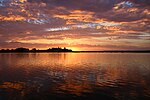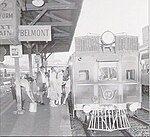Pirrita Island
City of Lake MacquarieUninhabited islands of AustraliaUse Australian English from March 2021
Pirrita Island is an island in the Swansea Channel in the City of Lake Macquarie of New South Wales, Australia. It is adjacent to the suburb of Swansea. The Awabakal people called the area of Swansea Galgabba, which means a place to rest. The area was a rich hunting and fishing ground for the original inhabitants.The island is a popular nature tourism spot, with walking trails and seasonal birdwatching. Migratory birds such as the Far Eastern curlew, Bar-tailed godwit, Pied oyster-catcher, White-faced heron, Crested tern, and Little egret come from as far as Siberia and Alaska to rest and feed.
Excerpt from the Wikipedia article Pirrita Island (License: CC BY-SA 3.0, Authors).Pirrita Island
Dobinson Drive, Lake Macquarie City Council
Geographical coordinates (GPS) Address Nearby Places Show on map
Geographical coordinates (GPS)
| Latitude | Longitude |
|---|---|
| N -33.072111111111 ° | E 151.63869444444 ° |
Address
Dobinson Drive
2281 Lake Macquarie City Council, Swansea
New South Wales, Australia
Open on Google Maps


